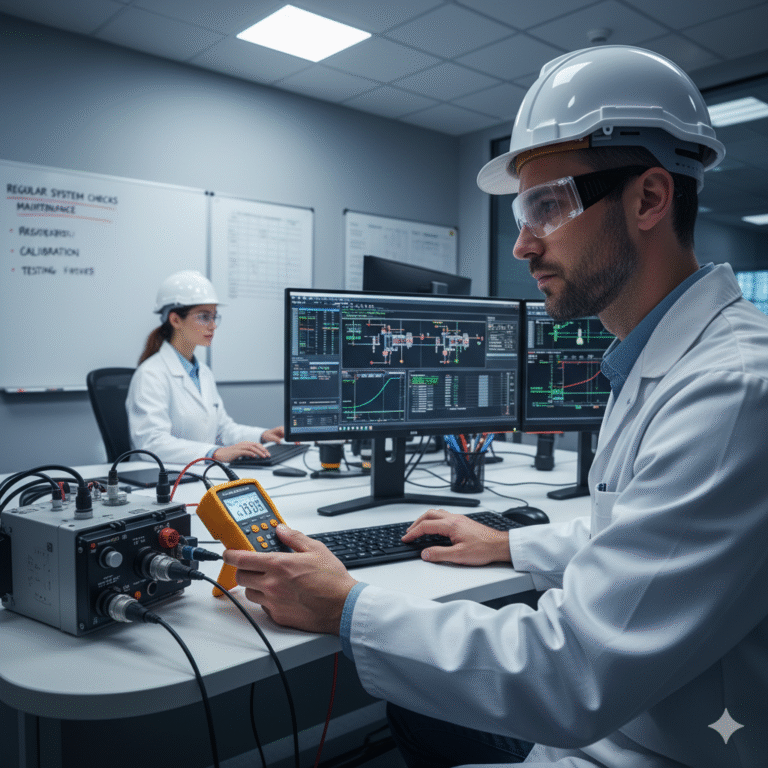As an instrument technician, it’s essential to learn how to proactively reflect on your work, summarize your experiences, and improve your maintenance skills. This process is key to transforming repetitive tasks into expert-level capabilities. Below is a comprehensive framework that moves from “reflection” to “improvement,” which you can apply based on your own experiences.
Part 1: How to Effectively Summarize Work Experience
Summarizing isn’t simply listing what was done; it’s about analyzing the “why” and “how” in depth.
Create a Personal Work Log (Core Habit)
Don’t rely on memory. Keep a notebook or digital document to record each significant maintenance case. The record template should include:Basic Information: Equipment name, location, failure time, process environment (temperature, pressure, medium, etc.).
Failure Symptoms: Describe in as much detail as possible (e.g., max indication, no display, severe fluctuations, alarm messages).
Diagnosis Process:
What observations were made?
What measurements were taken (current, voltage, resistance, continuity)?
What tests were conducted (e.g., zero calibration, signal simulation, component replacement)?
What was the initial judgment? How was it later confirmed or disproven?
Root Cause: What was the actual cause? (Not just “the transmitter is broken,” but something like “sensor diaphragm permanently deformed due to medium crystallization”).
Solution: How was it fixed (replaced, adjusted, cleaned, reprogrammed)?
Experience and Reflection:
Success: What approach or method worked particularly well in this repair?
Lessons Learned: What mistakes were made? What were the incorrect judgments, and why?
Improvement Suggestions: Does the equipment have design flaws? Could it be installed differently? Are there potential improvements or modifications?
Knowledge Gaps: What theoretical knowledge do you need to address (e.g., communication protocols, specific sensor principles, PLC logic)?

2. Regular Classification and Summary
At the end of each month or quarter, review your work logs and attempt to categorize the cases:
By Fault Type: Instrument drift, wiring issues, mechanical jamming, software configuration errors, power supply failures, etc.
By Instrument Type: Pressure, flow, level, temperature, analyzers, actuators (valves/motors), etc.
By Root Cause: Equipment aging, process changes (e.g., water hammer, cavitation), improper installation, wrong selection, external interference, etc.
By categorizing your cases, you’ll identify recurring “problem patterns,” which will help you develop a more predictive maintenance mindset.
3. Build Your Own “Knowledge Base” and “Case Library”
Organize your insights into more structured documents:
“Golden Rules”: Write down the quickest, most effective diagnostic procedures and tips for the most common instruments.
“Typical Fault Cases”: Organize the most challenging and typical cases, including schematics and data analysis.
“Technical Notes”: Document key takeaways from new technologies, products, or techniques you learn.

Part 2: How to Use Summarized Knowledge to Improve Maintenance Skills
Reflection is the “input,” while improvement is the “output” and “internalization.”
Shift from “Experience-Based” to “Analysis-Based” Maintenance
Beginner Level: Replacing parts based on intuition or experience (it may solve the problem, but without understanding the root cause).
Intermediate Level: Using your categorized “patterns” to quickly locate general fault types.
Expert Level:
Theory-Guided Practice: Use instrument principles and circuit knowledge to analyze faults. For example, why does pressure indication drift? Is it a bridge circuit issue or diaphragm problem?
Data Analysis: Learn to use historical trend curves in DCS/PLC systems to identify subtle clues before and after a fault. This is often crucial for identifying intermittent or complex faults.
Utilize Tools: Master tools like multimeters, process calibration instruments, HART/FF handheld devices, oscilloscopes, etc. Let data guide your decisions rather than guessing.
Develop Systematic Thinking
A malfunctioning instrument may not be the root cause.Look Upstream: Is the power supply stable? Is the fuse blown?
Look Downstream: Has the signal reached the system card? Is the card functioning properly?
Examine the Surrounding Environment: Are there vibrations, high temperatures, corrosion, or electromagnetic interference?
Check the Process: Have there been dramatic process changes? Have the instrument’s operating parameters been exceeded?
Record these system connections in your summary to broaden your troubleshooting perspective in the future.
Actively Learn and Fill Knowledge Gaps
The “knowledge gaps” identified in your summary should guide your learning.Lack of Theory: Look for textbooks or technical manuals to clarify working principles. For instance, if you don’t understand radar level meter principles, you’ll struggle with issues like false echoes.
Lack of New Skills: If your factory introduces a new instrument model (e.g., Coriolis mass flowmeter) or new communication protocols (e.g., PROFIBUS PA), proactively learn through training or reading manuals.
Cross-Disciplinary Learning: Understanding process, mechanical, and electrical knowledge will help you better understand the role of instruments and the interconnections with other systems in the plant.
Share and Collaborate
Discuss with Colleagues: Share typical cases and listen to others’ ideas. “Two heads are better than one,” and you may find new insights.
Consult Experienced Technicians/Experts: A simple piece of advice from a seasoned professional might solve a problem you’ve been struggling with for hours.
Write Technical Reports: Try to write formal reports for major or typical fault analyses. This process forces you to organize your thoughts and deepen your understanding.
Promote Preventive Maintenance and Improvements
This represents the highest value in maintenance work.Based on your summaries, offer suggestions for improvements:
“A pressure transmitter frequently fails due to water hammer. Recommend adding a damper to the sample line.”
“A batch of temperature sensors has a shorter lifespan than expected. Suggest checking if the selection is appropriate for actual conditions.”
“The grounding system is not standard, causing frequent signal interference. Recommend corrective actions.”
Create Standard Operating Procedures (SOPs): Formalize the best repair methods you’ve discovered into standardized procedures for broader use in your department.

Conclusion: A Continuous Cycle
Practice → Record → Summarize → Learn → Reapply → Improve
Treat each maintenance task as a learning case and every fault as a research subject. By consistently summarizing and focusing your learning, you can grow from simply replacing parts to becoming a technician capable of diagnosing precisely, eliminating problems, and even predicting risks.
This journey has no shortcuts, but you’re already on the right path. Wishing you success in becoming an expert in the field of instrumentation and fault handling!
